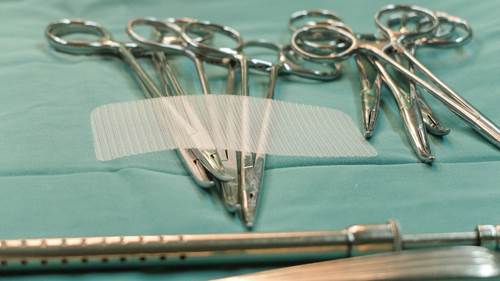Updated
Infection can be a complication of defective hernia mesh and repair surgery. Seven common signs and symptoms of hernia mesh infection include:
- Fever
- Inflammation
- Redness
- Burning
- Pain
- Flu-like symptoms
- Swollen lymph nodes
Infection typically occurs in 7% to 8% of patients after open incisional hernia repair surgery. In laparoscopic ventral and incisional surgeries, the infection rate decreases to 0.98% to 2%.1
Patients who suffer an infection may be eligible to file a hernia mesh lawsuit and obtain compensatory damages.
In this article, our attorneys at Shouse Law Group answer frequently-asked-questions about infections from hernia mesh devices and operations.
- 1. What are the signs and symptoms of infection after hernia repair surgery?
- 2. What are other signs of infection?
- 3. Are there some patients more prone to mesh-related infection?
- 4. What if the infection goes untreated?
- 5. How is infection diagnosed and treated?
- 6. Are there any mesh products more prone to infection?
- 7. Should I contact a personal injury lawyer?

Many hernia mesh patients develop staphylococcus and/or MRSA infections.
1. What are the signs and symptoms of infection from a hernia mesh?
Below are seven common signs of infection to look out for if you have had hernia mesh repair surgery.
1.1 Fever
When a hernia mesh medical device causes an infection, the patient’s body temperature may rise in an attempt to kill off the bad bacteria. The body’s white blood cells produce chemicals called pyrogens to bind with the brain’s hypothalamus — which regulates body temperature.
It is normal for body temperature to fluctuate throughout the day. But a persistent fever above 100.4 is a cause for concern.
1.2 Inflammation
After surgery, the site of the area where the implantation operation occurred is always going to feel a bit sore. But if that tenderness also becomes swollen and/or painful, it could mean the abdomen is inflamed.
Many mesh products use or used Polypropylene. This is a synthetic resin known to cause inflammation, which can lead to serious complications.
1.3 Redness at the site
A little redness is normal in the days following a hernia repair surgery. But if the surgical site remains red or becomes red later, it may indicate an infected mesh.
Depending on the extent of the infection, the red or pinkish skin may be tender to the touch. The red skin may also be accompanied by seromas (fluid).
1.4 Burning sensation at the site
Like redness, a burning sensation at the mesh incision site can signal an infection. The clinical name for this burning is paresthesia.
This burning may be mild or severe, sporadic or chronic. But any burning that persists should be checked out by a doctor.
1.5 Pain
Abdominal pain – from mild to severe pain – is a common sign of infection (as well as of bowel obstruction, organ perforation, mesh migration, and other hernia mesh complications). Left untreated, infections may cause scar tissue and nerve damage.
Patients with an inguinal hernia or femoral hernia repair should pay extra attention to the incision site. If it becomes painful to walk or conduct day-to-day activities, then there may be an infection.
1.6 Flu-like symptoms
If your body is fighting an infection, you may experience traditional flu symptoms:
- Body aches,
- Chills,
- Nausea,
- Fever, and/or
- Vomiting.
If you experience these symptoms after hernia repair surgery with mesh, seek immediate medical attention.
1.7 Swollen lymph node
Lymph nodes/glands are like the body’s filters. They trap bad bacteria and viruses to keep them from infecting other parts of the body.
When nodes swell, it is often a sign that the body is fighting an infection. People with past hernia mesh surgeries who notice that their groin lymph glands are swollen should see a doctor right away.2
2. What are some other signs of infection?
Other possible signs and side effects of infections include:
- Failure to heal
- Dental problems
- Swelling or hardening at the incision site
- Drainage at the incision site
- Urinary tract infections
- Pneumonia
- Diarrhea
- General malaise
Infection can occur at any time. They typically occur within 17 months of an inguinal or incisional mesh implant.3
3. Are some patients more prone to mesh-related infection?
Hernia patients could be more likely to develop an infection if they suffer from these risk factors / co-morbidities:
- Diabetes
- Immunosuppression
- COPD
- Being a smoker
- Obesity4

Hernia mesh victims may be able to recover a large financial reward for their medical bills, pain and suffering, and lost wages.
4. What if the infection goes untreated?
If untreated or not treated in due time, a mesh-related infection can be the cause of:
- Delayed healing
- Implant rejection or migration
- Hernia recurrence
- Organ damage
- Abdominal abscess
- Peritonitis
- Intestinal fistula
- Adhesions
- Sepsis
- Cancer
- Death
You could also suffer from chronic pain or may be required to have additional surgery to remove the mesh, which poses its own risks.
In the most serious cases, an infection can destroy the surrounding tissue and induce large hernias. If the tissue is destroyed, it may be difficult to provide a permanent solution to your hernia problem.
5. How is infection diagnosed and treated?
Radiological imaging can help your physician determine if the mesh is indeed infected. Examples include ultrasounds and CT scans.
Once the patient is diagnosed with an infection, medical and surgical treatment may be necessary. The combination of the two would include antibiotics, intravenous antimicrobial agents, and/or surgery for mesh removal.
A study concluded that 63% of patients with mesh-related infections are infected with MRSA (methicillin-resistant bacteria).5 Unlike staphylococcal bacteria, MRSA is extremely difficult to treat.
In addition, antibiotics may not even be able to reach the infected area since bacteria creates a biofilm capsule around the mesh. This is why surgery is often required to treat infections.
6. Are there any mesh products more prone to infection?
Physiomesh and Atrium C-QUR mesh are the subjects of lawsuits specifically due to mesh-related infections. They use polypropylene mesh, a problematic synthetic mesh.
Extended polytetrafluoroethylene (ePTFE) and polyethylene terephthalate (polyester) are also prone to infection. And mesh with small pores tend to trap bacteria more than mesh with large pores. The safest pore size is 75 micrometers.
Hernia patients should speak with their surgeons about alternatives to synthetic meshes, such as biologic meshes. 6

Call our mass tort hernia mesh attorneys today for legal advice.
7. Should I contact a personal injury lawyer?
Yes. People who suffered an incidence of infection from their hernia mesh or revision surgery may be entitled to large financial compensation from the manufacturer and/or their surgeon.
Currently there are federal multi-district litigations (MDLs) against Ethicon in Georgia, Bard Davol in Ohio, and Atrium in New Hampshire – amounting to more than 18,000 plaintiffs. And thousands of victims are bringing individual lawsuits against Covidien and Gore.
Our lawyers at Shouse Law Group create attorney-client relationships throughout the United States with victims who have suffered injuries from defective mesh products. Call our law firm today for a free consultation. We take no money unless we win your case.
References
- Falagas, M.E., and Kasiakou, S.K. Mesh-related infections after hernia repair surgery. Clinical Microbiology and Infection. November 29, 2004. See also Arnold, M.R. et al., Optimal management of mesh infection: Evidence and treatment options., Hernia Surgery Journal (2018). See also Radwan Dipp Ramos, et al., Re-Infection after Explantation of Infected Hernia Mesh: Are the Same Micro-Organisms Involved?, Surgical Infections (August 12, 2021). Christine Tung, Short-Term Outcomes Following Removal of Infected Hernia Mesh, The American Surgeon (July 15, 2021).
- See, e.g., Tao Chen, Yun-He Zhang, Hao-Lu Wang, Wei Chen, and Jian Wang, “Late-onset Deep Mesh Infection: A Study of Eight Cases Detected from 2666 Consecutive Patients with Abdominal Wall Hernia Repairs“, Chin Med J (Aug 5. 2016); Surgical Site Infections, Johns Hopkins Medicine; FDA. Hernia Surgical Mesh Implants. Last Updated: 02/02/2018.
- Id.
- See note 1.
- Cobb, W.S., Harris, J.B., Lokey, J.S., McGill, E.S., Klove, K.L. Incisional herniorrhaphy with intraperitoneal composite mesh: a report of 95 cases. Am Surg. 2003 Sep;69(9):784-7.
- In RE: Matthew Huff v. Ethicon Inc, at 2. Case No. 3:16-cv-00368. Document 1. Filed 04/01/16; In RE: Theresa Callaway v. Atrium Medical Corporation. Case No. 1:16-cv-04068. Document 1. Filed 10/31/16. Brown, C.N. & Finch, J.G., Which mesh for hernia repair? Ann R Coll Surg Engl. (2010).
